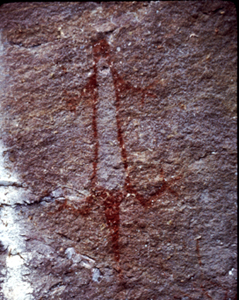What threatens to destroy rock art?
Rock art is durable but not indestructible. Both human activities and natural events pose threats to Arkansas rock art. The primary human threat to rock art is vandalism. We find many images defaced by graffiti or other kinds of intentional damage to the rock surface. Some people who leave their initials and other messages with spray paint or felt markers may not have noticed the faded ancient images, but in other cases it is easy to see that the damage was done deliberately. Occasionally well-meaning people who are interested in the rock art try to "enhance" its appearance with chalk or some other material, but studies have shown that this alters the delicate microenvironment of the rock surface and can harm fragile images. Adding chalk or other modern substances to a pictograph permanently destroys any hope of using radiocarbon techniques to date the pigment. Natural threats to rock art are the normal processes of weathering and erosion. Exposure to intense sunlight can fade the pigments used in many pictographs. Anything that wears away exposed rock surfaces, such as wind-born grit and running water, can bring about the gradual destruction of rock art. Plants that grow on rock such as lichen or moss don't just cover rock art; the tiny roots penetrate the rock surface, causing it to scale and crumble over time. Mineral deposits can gradually mask rock art elements. Aside from these cumulative, small-scale processes, major events such as earthquakes and tremors and fracturing from freeze-and-thaw cycles can cause breakage of surfaces containing rock art.
No one can prevent these natural earth processes, though it is sometimes possible to devise effective ways to protect important rock art sites from their effects. Across centuries these forces have resulted in losses that are hard to calculate. Recently scientists have debated whether the interaction of human behavior and earth process has brought about a more rapid destruction of some rock art. For instance, has air pollution from industry and the resulting acid rain caused pictographs to fade at a measurably faster rate? For now, the only destructive impacts that we can certainly prevent are those that result from our own hands. |
| Home | Quick Facts | Interpretations | Articles | Technical Papers | Resources | Database | Just For Kids | Picture Gallery | Buy the Book! |
|
Last Updated: April 9, 2007 at 9:09:01 AM Central Time
|


